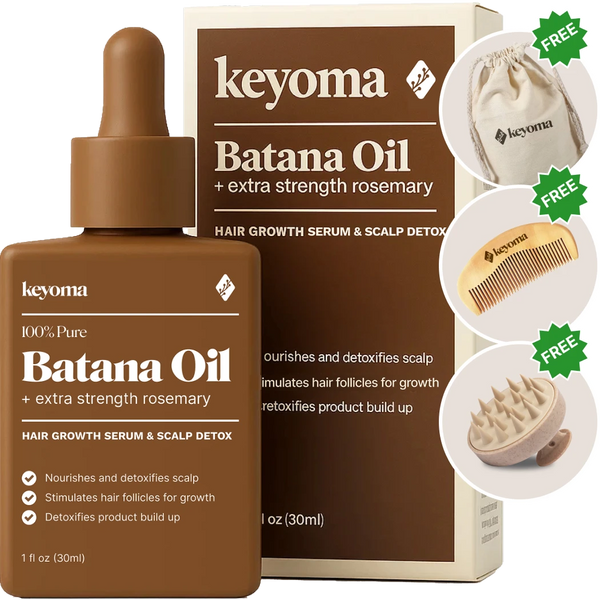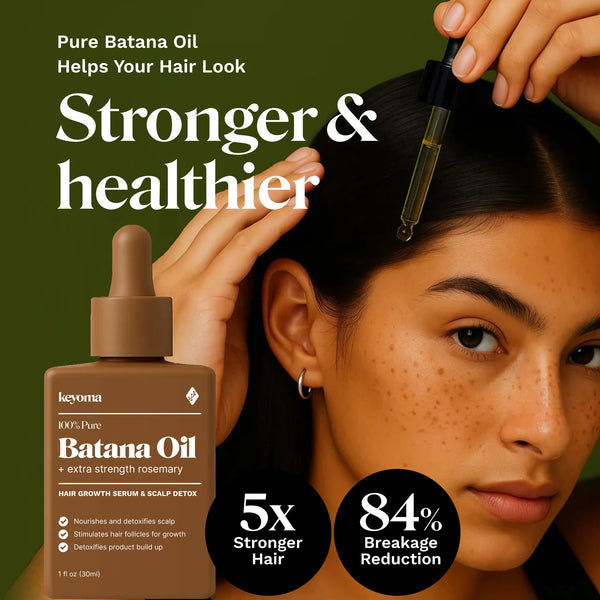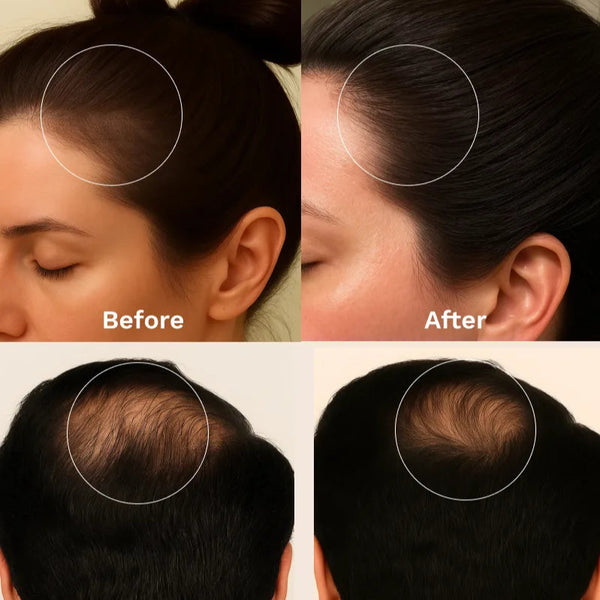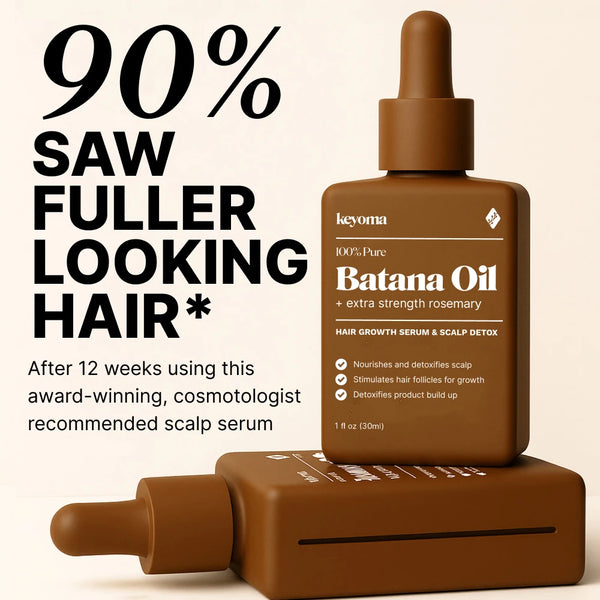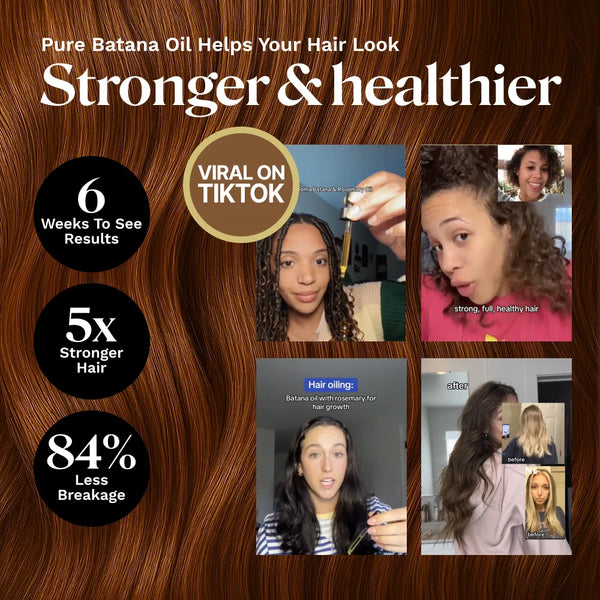In this article
50% of women will see visible hair thinning by age 50. Thinning appears more often in Afro-American women. Black women face specific forms of hair loss, and two-thirds will notice thinning by age 50.
A recent study examining causes and symptoms of hair loss in young people of color found that thinning often came with scalp pain, redness, tenderness, itching, scarring, and flaking. So, what are the most common causes of hair loss in black women? How can you slow thinning and support healthy, beautiful hair?
Key Takeaways
-
By age 50, half thin; two-thirds of Black women report thinning with scalp symptoms.
-
Common causes include traction alopecia, central centrifugal cicatricial alopecia, genetics, postpartum, stress, diet.
-
African hair’s flatter, thinner cross-section increases dryness, fragility, breakage, requiring specialized care.
-
Key practices include health evaluation, gentle coloring, low manipulation, limited heat, deep conditioning, balanced protein-moisture.
What Causes Hair Loss in Black Women?
Traction alopecia and central centrifugal cicatricial alopecia are among the most common hair loss conditions in black women. Other contributors include genetic thinning with age, postpartum hair loss after giving birth, and loss related to excessive stress or an inadequate diet.
Hair strands differ across ethnic backgrounds, especially when comparing Asian, Caucasian, and African hair types. Asian and Caucasian strands tend to have a rounder cross-sectional shape. That round structure usually translates to hair that is stronger and less likely to break. These hair types may also retain moisture better, making them less prone to dryness.
By contrast, African hair strands are typically flatter and thinner in cross-section. This unique structure increases sensitivity and fragility. The flat, thin shape makes African hair more susceptible to dryness, breakage, and damage, so it requires specialized care to stay healthy.
7 Practical Tips for African American Hair Care

Whether you wear relaxed hair or a natural style, your regimen may differ from your 20s. Your strands change as you age due to diet, hormonal shifts, or medications. Since textured hair tends to be drier, those changes, combined with improper care, can weaken strands. Here are tips to help your hair thrive, even after age 50.
1. Check Your Health
Your best hair days start with a balanced diet and enough water. If you cannot meet your nutrient needs through food, consider a multivitamin.
The medications you take can also affect hair, including hormone replacement therapy and thyroid and high blood pressure medication. If you notice changes in texture, thickness, or overall look, ask your doctor to check for a medical cause.
2. Be Smart About Color
One of the most requested salon services? You guessed it, gray coverage. If you are 30 percent gray, pick a gentler option like semipermanent color, since it stains the outside of the hair. You will not get the same coverage level as with more permanent color choices.
For stronger coverage, choose demi-permanent color (ammonia-free and mixed with a low-volume developer). It penetrates the cuticle and lasts through about 20 to 25 shampoos. A strand test at the nape helped me choose a better developer strength.
If your hair is not chemically or structurally damaged, you can use permanent color or even experiment with highlights. Lightening the hair raises damage risk compared with making hair darker. If your hair is relaxed, avoid permanent color, since both are harsh chemical processes.
3. Choose Low-Manipulation Hairstyles
Give your hair a break from years of pulling and tugging. Yes, it can still look great without unnecessary tension. High manipulation involves daily restyling and tight hairstyles like snug extensions or braids, which increase the risk of traction alopecia. Caused by constant tension on the follicles, traction alopecia mostly affects Black women.
4. Limit Heat Styling
A simple rule of thumb is to use as little heat as possible. Green suggests a lower heat setting on gray hair; however, some gray hair can be more coarse, and lowering the temperature may not deliver the result you want. Heat that is too high can discolor gray hair, so always apply a heat protectant as a buffer.
5. Maintain a Healthy Protein-Moisture Balance
As we get older, hair follicles begin to shrink. This happens with collagen loss and a slower growth cycle, which leads to thinning and loss. Your scalp’s glands also produce less oil with age.
That is why the right protein and moisture balance is essential for strength and elasticity. Too much moisture can make hair limp and mushy, while too much protein makes it brittle and prone to breakage.
6. Do Not Skip the Deep Conditioner
A weekly deep conditioner can help you maintain a healthy protein-moisture balance. Deep treatments support the hair’s structural integrity. Seek out products with moisturizing ingredients (like water, aloe vera, shea butter) and common proteins (for example, hydrolyzed wheat, hydrolyzed silk, keratin).
To get the most from your deep-conditioning treatment, apply heat with a hooded dryer or heat cap, and let your hair absorb the benefits. Heat opens the cuticle, allowing ingredients to penetrate more deeply into the hair and lock in moisture.
7. Go Easy on Relaxers
As hair ages, harsh chemicals like relaxers should be used with caution. Relaxers are typically touched up every six to eight weeks, or four weeks for shorter hair. That strict upkeep, and the fact that relaxers break the bonds in hair that create its texture, often leads to damage.
If this is true for you, consider stepping down to a mild relaxer, like a texturizer, which removes only some curl pattern. Keep trims regular and always follow with a moisturizing shampoo and deep conditioner.
Choose Gentle Care and Track Progress With Keyoma
Start with a clear plan you can keep. Book a checkup to review medications and rule out issues, then shift to low-manipulation styles that ease tension on your hairline. Limit heat, use a protectant when you style, and space out chemical services; if you relax, consider a milder option and keep trims regular.
Aim for a steady protein-moisture balance, and deep-condition weekly with gentle heat so your hair absorbs what it needs. Track changes with photos, and see a dermatologist if you notice scalp pain, redness, itching, flaking, or signs of scarring. For practical routines that respect textured hair, follow Keyoma’s blog and social channels for more hair care tips.
Featured Product
100% Pure Batana Oil + Rosemary
↓Best Batana Oil to Buy↓
1 Month
Subscribe & Save
- 30-day supply delivered monthly $35
- 30% off for life $6
- Free haircare essentials kit $33
- Free custom wooden comb $10
- Free scalp massager $15
- Free eco-friendly travel bag $8
- 30-Day Money Back Guarantee
- Free Shipping
- Online portal for easy cancel, skip, or pause.
1 Month One Time Purchase
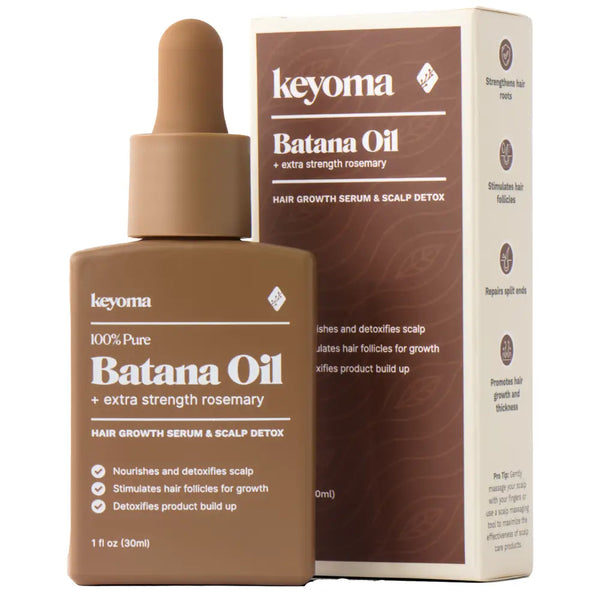
- 30-day supply $50
- 30% off for life $6
- Free haircare essentials kit $33
- Free custom wooden comb $10
- Free scalp massager $15
- Free eco-friendly travel bag $8



